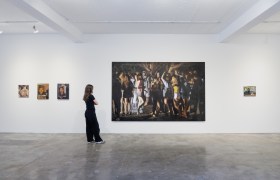I had 18 minutes instead of 15 because of tenacity, the will of the cockroach.
— Henry Rollins in an interview with The Onion
So I’m here: bright lights, big city — like everyone else I’ve come to New York from overseas to start again, to make something of myself. To work as a writer, to work in the theatre.
For all of America’s political failings, braggadocio, and cultural frothiness, the fresh desire to start a new life, embodied by the City Upon the Hill speech of 1630 before the Puritans alighted in the New World (a desire which when skewed slightly ends in genocide, fanaticism, and cultural imperialism) was originally a desire for something good. And I’m here like every other schmuck to get me some of that zesty fresh make-myself goodness. To make art.
The truth is, it’s cheaper in my country to make theatre. The opportunities are fewer but you don’t have to slice pounds of flesh from your body for rental of a downtown theatre (approx $2500/week for a small space, i.e. 60-80 seats). The truth is, if I’d stayed in my country, and lived a clean, green, easy life, I’d still be bumbling along in boredom. But I wouldn’t be having Kafkaesque encounters (in my paranoid unconscious at least) with Homeland Security. I wouldn’t be bargaining with the devil for a visa.
Last year, I went to see my legal advisor about my status in this United States. He sat in a shoebox-sized room surrounded by precarious, disordered towers of paper, his suspenders pulled tight over his giant gut, his white shirt dotted with greasy hero stains. He was wedged into his windowless office, chair tipped back at an angle so his belly could fit behind his desk, balanced just so, trying to weight the scales of justice for small-time artists like myself. This was a man who has been known to punctuate his advice with burps. My life was in his hands. He cut straight through my “Sorry I’m late… subway” excuses and barked: “Whadda ya want?”
What do I want? What do I want? I want to be paid to write plays that shoot straight to Broadway, I want to sell out and have my own house in the Hamptons to escape the hum and drip of the ACs in sticky New York summer, I want to walk in the East Village in spring when the light is turning purplish-white, I want to eat crunchy-chewy bagels with mounds of cream cheese, I want to stroll through Central Park in autumn (as I did last fall) with my American man, I want to sit on the subway as it hurtles through space at an alarming speed and imagine it rocketing through the ceiling like the elevator in Willy Wonka and the Chocolate Factory (the 1971 Gene Wilder version, of course). In short: I want to stay in New York. But I daren’t declare this to anyone who might be listening, least of all to the police officers ambling around the subway, or the men in fatigues in Grand Central station or my interviewer behind plate glass at the American consulate. So instead I replied: “I am an artist, I want a visa.”
There is one kind of visa in this country which applies specifically to artists — it’s called an O-1 visa. The US government definition is this:
“O-1 classification applies to persons who have extraordinary ability in the sciences, arts, education, business, or athletics, or extraordinary achievements in the motion picture and television field.”
Of course the arts is a broad domain and can encompass various things: fine arts, visual arts, performing arts, culinary arts. Aside from your average writer or painter, the category can apply to directors, choreographers, make-up artists and animal trainers. Animal trainers? Yes, animal trainers. Heralded with all this information, my brain began to race: who decides whether or not I am, indeed, “extraordinary” in my artistry, and how do they make this subjective and irrevocable decision? And what about the animal trainers?
I put all this to my legal advisor and he told me I needed to put together a portfolio of all my work: “The glossier the better,” he said. I must also have many, many letters of recommendation. I must also have a sponsor, or an agent through which all my employment and wages are channeled. I must appeal to the good judgment of those who confer the moniker of “extraordinary,” whilst they go about their no doubt very ordinary jobs working for the US government. He then pointed to a thick binder, the portfolio for a visual artist from Eastern Europe. “He was the most qualified person I’ve submitted for this visa,” he grunted. “He got rejected.”
“Why?” I asked. He just shrugged in reply.
I emerged from his office into the dazzling cold light of winter, and briefly fantasized about overstaying my visa, and cutting a trail of dust in my Cadillac as I sped through the desert in Arizona with the immigration sheriff hot on my tail, replete with aviator shades and giant mustache. And even if I got away from the sheriff I would never see my family again, or if he tracked me down, I would be deported and disbarred from re-entering the US for up to 10 years.
I decided that I would have to find a way. I would have to harness what Henry Rollins refers to as “the will of the cockroach,” the ability to hold on as an artist through thick and thin. I would have to prove, some way or another, that I was extraordinary.
Editor’s note: Hereafter W. Darling’s odyssey will be chronicled in an occasional column entitled Extraordinary Aliens.




